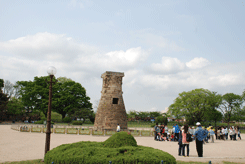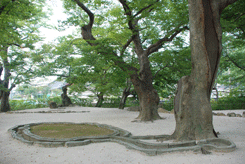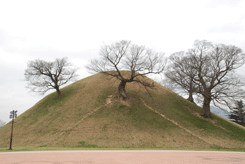EXCURSIONS
Gyeongju 3 days



Tour Highlights
- Yangdongmaeul Village
- Seokguram Grotto
- Bulguksa Temple
- Gyeongju National Museum
- Donggung Palace adn Wolji Pond
- Cheomseongdae Astronomical Observatory
- Tumuli Park
Click on the days to access the program quick
| Days | Visits and Activities | Distance |
| Day 1 | Seoul - Yangdong - Gyeongju | 420km |
| Day 2 | Gyeongju | |
| Day 3 | Gyeongju - Seoul | 360km |
Day 1 Seoul - Yangdong - Gyeongju (- - -) 420km
 Your tour guide greets you in your hotel lobby and takes you on an excursion to Gyeongju. Enjoy a pleasant two hours journey on a speed train across the picturesque countryside to Gyeongju, an ancient capital of the Silla dynasty (BC57-AD935), often dubbed as Museum without Walls. As leisurely make your way to Gyeongju, you will see Korea's fertile farmland, glistening brooks, sheltered ginseng farms, apple plantations and lovely rice paddies that together forming a patchwork of colors and ever-changing textures of the rural Korean life. Today, you are in one of the ten most historically significant sites in the world with ancient temples, weathered stone pagodas, royal tombs, Buddhist bas-reliefs, and fortress ruins.
Your tour guide greets you in your hotel lobby and takes you on an excursion to Gyeongju. Enjoy a pleasant two hours journey on a speed train across the picturesque countryside to Gyeongju, an ancient capital of the Silla dynasty (BC57-AD935), often dubbed as Museum without Walls. As leisurely make your way to Gyeongju, you will see Korea's fertile farmland, glistening brooks, sheltered ginseng farms, apple plantations and lovely rice paddies that together forming a patchwork of colors and ever-changing textures of the rural Korean life. Today, you are in one of the ten most historically significant sites in the world with ancient temples, weathered stone pagodas, royal tombs, Buddhist bas-reliefs, and fortress ruins.Explore the UNESCO World Heritage Site, Yangdongmaeul, a delightful journey to the traditional clan village which embraces simple, unadorned natural beauty. There are some steep hills to climb but also easier streets. Over 150 homes as well as two shrines are in perfect harmony with the natural topography, presenting different angles where walls ascend a hill interspersed with tiled roof houses or thatched roof buildings.
Day 2 Gyeongju (B)
With a full day to further explore the delights of UNESCO World Heritage Site, Seokguram grotto. It is the home of the serene stone Buddha of the eighth century. Inside, a white statue of a seated Buddha in a sublime state of enlightenment, is surrounded by 37 relief figures of Bodhisattvas, disciples, devas, and guardian kings. The grotto represents the magnificent harmony of religion, science and the arts of Buddhism, symbolizing the pure land in which Buddha resides.
A short ride leads you to another UNESCO World Heritage Site, Bulguksa temple, where you will witness the impressive gates, symbolic bridges leading up to the world of Buddha, graceful architectures, Three-storied Seokgatap and highly ornate Dabotap blending well into the architectural harmony. At Gwaneumjeon hall, check out the image of the Avalokitesvara who is referred to as the Bodhisattva of Compassion and has a thousand hands, and eyes in each so as to reach out to those in need of help. You will see a gilded statue of Vairocana with the gesture of the first wisdom, Sakyamuni Buddha attended by two bodhisattvas along with sixteen figures of Buddha's disciples sitting in deep meditation, and a gilt-bronze Amitabha Buddha, the ruler of the Western Paradise Sukhavati. The architectural design of Bulguksa is one of constrained dignity, peace, and harmony and the temple still remains one of the most remarkable achievements of the ancient Far East.
The Gyeongju Historic Areas contain a remarkable concentration of outstanding examples of Korean Buddhist art, in the form of sculptures, reliefs, pagodas, and the remains of temples and palaces from the flowering, in particular between the 7th and 10th centuries, of this form of unique artistic expression.
Visit Gyeongju National Museum.The first thing that you will notice is The Bell of King Seongdeok, the largest extant bell in Korea. You must certainly stand in awe before the bell from the 8th century with such artistic beauty of design. The bell is distinguished not only for its outstanding beauty but also for its long reverberating sound, the incredibly precise casting technique, in addition to the sad legend surrounding it. On entering the museum, you will marvel at the priceless archaeological and historical artifacts including splendid gold crowns, earrings, belts, ornaments, glassware, potteries, and clay figures as well as a royal barge.
Continue your historic discovery by exploring Donggung palace and Wolji pond, a pleasure garden built to commemorate the victory of Silla. You will tour the world's oldest existing astronomical observatory, Cheomseongdae and finally Tumuli Park that encompasses 23 huge burial mounds. You can go inside Cheonmachong and see how the tombs were made and replicas of the treasures excavated in 1973.
Day 3 Gyeongju - Seoul (B) 360km
With leisurely time to pack, return on a speed train to Seoul.






